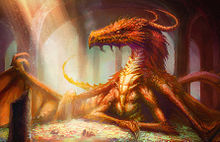Dragons in Middle-earth
| Dragons | |
|---|---|
| In-universe information | |
| Created by | Withered Heath, Lonely Mountain |
| Sub-races | Fire-drakes Cold-drakes |
Dragons appear in the early stories of The Book of Lost Tales, including the mechanical war-dragons of The Fall of Gondolin. Tolkien went on to create Smaug, a powerful and terrifying adversary, in The Hobbit; dragons are only mentioned in passing in The Lord of the Rings.
Tolkien's conception of the dragon has been adopted both in games loosely based on his Middle-earth writings, and by other
Development
Dragons are already present in
Characteristics
In Tolkien's works, dragons are
Named dragons
Tolkien named only four dragons in his Middle-earth writings. Another,
Glaurung
Glaurung, first introduced in The Silmarillion, is described as the Father of Dragons in Tolkien's legendarium, and the first of the Urulóki, the Fire-drakes of
Ancalagon the Black

Ancalagon the Black (
Scatha
Scatha was a mighty "long-worm" of the
Smaug

Smaug was the last named dragon of Middle-earth. He was slain by
Analysis
Tolkien's dragons were inspired by medieval stories, including those about
The scholar of Icelandic literature Ármann Jakobsson writes that with the encounter with Smaug, the story in The Hobbit becomes "more unexpected, entangled, ambiguous, and political". He argues that Tolkien was effectively translating the subtext of his Old Norse sources, creating in his dragon a far more subtle, uncanny, and frightening monster than those in the earlier, more or less unconnected, travel narrative episodes.[5]
The use of dragons as an
Legacy
In games and novels
When
Honegger writes that Tolkien's conception of dragons "as intelligent beings with a distinct personality" has been adopted by fantasy authors with a wide range of styles, including Barbara Hambly, Ursula K. Le Guin, Anne McCaffrey, Christopher Paolini, and Jane Yolen.[7]
In science
Several taxa have been named after Tolkien's dragons. Two extinct genera have been named after Ancalagon:
References
Primary
- ISBN 0 04 820015 8
- ^ a b Tolkien 1984b, ch. 2 "Turambar and the Foalókë"
- ^ Tolkien 1955, Appendix B, "The Third Age"
- ^ a b c Tolkien 1977, ch. 24 "Of the Voyage of Eärendil and the War of Wrath"
- ^ Tolkien 1977, ch. 13 "Of the Return of the Noldor"
- ^ Tolkien 1955, Appendix A, "Durin's Folk"
- ^ Tolkien 1954a, book 1, ch. 2 "The Shadow of the Past"
- George Allen & Unwin. p. 25.
- ^ Tolkien 2007, ch. 17 "The Death of Glaurung"
- ^ Tolkien 2007, ch. 14 "The Journey of Morwen and Niënor to Nargothrond"
- The Etymologies, pp. 348, 362
- ^ Tolkien 1955, Appendix A, "The House of Eorl"
- ISBN 0 00 720308 X
- ^ Tolkien 1937, ch. 14 "Fire and Water" and throughout
Secondary
- ^ ISBN 978-0261-10401-3.
- ^ ISBN 978-1-4039-4671-3.
- S2CID 170851865.
- S2CID 216644043.
- S2CID 170310560.
- Clarendon Press.
- ^ ISBN 978-3-631-58219-0.
- ISBN 978-1-5580-6216-0.
- ISBN 0-87349-623-X.
- ^ Radcliffe, Doug (20 March 2006). "The Lord of the Rings, The Battle for Middle-earth II Walkthrough". GameSpot. Retrieved 28 March 2016.
- ^ Miller, Greg (18 January 2012). "Lord of the Rings: War in the North Blowout". IGN. Retrieved 24 January 2021.
- ^ "Ancalagon minor". The Burgess Shale. Retrieved 26 December 2022.
- JSTOR 1304185.
- S2CID 87461613.
- ^ "Protect and Prosper". American Museum of Natural History. Retrieved 30 August 2015.
- PMID 20816817.
- Entomology Today. Annapolis, Maryland: Entomological Society of America. Retrieved 20 March 2016.
- .
- ISBN 978-1-77557-073-8.
Sources
- ISBN 978-0-618-13470-0.
- OCLC 9552942.
- OCLC 519647821.
- ISBN 978-0-395-25730-2.
- ISBN 0-395-36614-3.
- ISBN 0-395-45519-7.
- ISBN 0-007-24622-6.

